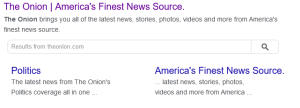Chapter 3: Post-Secondary Learning
26 Credible Sources
Finding credible sources is more important than ever. We live in an information-rich world where we can find information within a matter of seconds in the palm of our hands but finding accurate and credible information can be challenging.
For example, you may or may not be familiar with The Onion, a satire news website. If you are not familiar with the site and you come across it in search results, you will see this:

You can see the byline under the heading is “The Onion brings you all the latest news, stories, photos, videos, and more from America’s finest news source.” If you were to come across this, there is nothing to suggest to you that The Onion is a satirical news site.
Once you arrive on the site you will see it is designed much like any other news website. It has newspaper-style headlines with smaller byline text, images, organized in a grid, ads, etc.

If you aren’t reading thoughtfully and critically, you could mistake one of these stories for a credible news source.
Sharing inaccurate information is not only detrimental to your grade, but also to your reputation. But the motivation to find, use, and share accurate and credible information should not just be your grades and reputation. You should use credible and accurate information because it is the moral thing to do. However, simply knowing that we need to find credible information only gets us halfway there! Learning how to actually find it is what really counts.
Tips to Finding Credible Sources
Requirements for credible sources differ depending on the discipline, where generally, a credible source is unbiased and supports academic references, which are backed by well-known researchers. It is important to cite any work that is not solely yours to provide proper credit to the author of the work that is used in your work.
Some tips to keep in mind when identifying credible sources are:
- Who are the authors? Are they respected and well-known in the field? Trustworthy and credible authors will always cite the sources they used to ensure the accuracy of and support for their work. Have the authors written about other similar topics? What are their credentials and education?
- Is the source in-depth, with an abstract, a reference list, and documented research or data? Is the information relatively current and up to date for information on technologies?
- Who is the audience? Are they researchers, professors, students, the general population, professionals in a specific field? Is the source targeted to the audience you wish to obtain information for?
- What is the purpose of the source? Does it provide information or report original research? What is the tone of the author? Who is funding the research or writing of this source?
- Is the source reputable? Is it published on a reputable, unbiased website? Is it a peer-reviewed, scholarly journal? Stay away from a newspaper, blog, or Wikipedia.
- Is there supporting documentation? Are there graphs, charts, illustrations or other supporting documentation? Are those documentations properly cited in the work?
Video: Evaluating Sources for Credibility
Watch the video “Evaluating Sources for Credibility” [3:14] to review some ways you can evaluate sources for reliability.
Referencing and Citation Guidelines
The Cambrian College Library & Learning Centre has citation resources for you to refer to. You know that it is important to cite and when to cite, but how do you cite something? Well, that will depend on your program and your school’s citation requirements. The two most common citation styles are American Psychological Association (APA) and Modern Language Association (MLA), but there are many others.
There is no need to memorize all the rules to your citation style, however, there is a need to be familiar with the details you need from the source. Use the resources from your library or online sources and keep them handy (bookmark them or print them out) for easy access.
A few detailed guidelines on a few citation styles :

